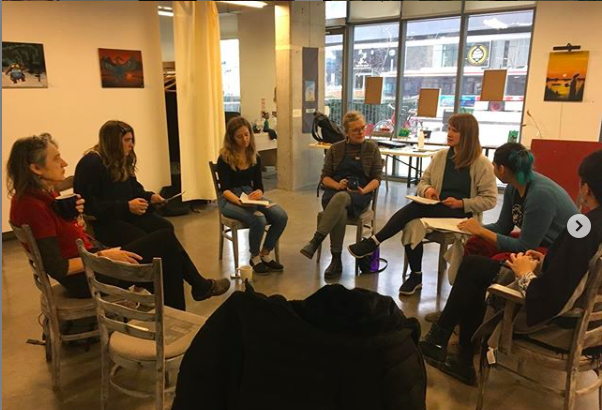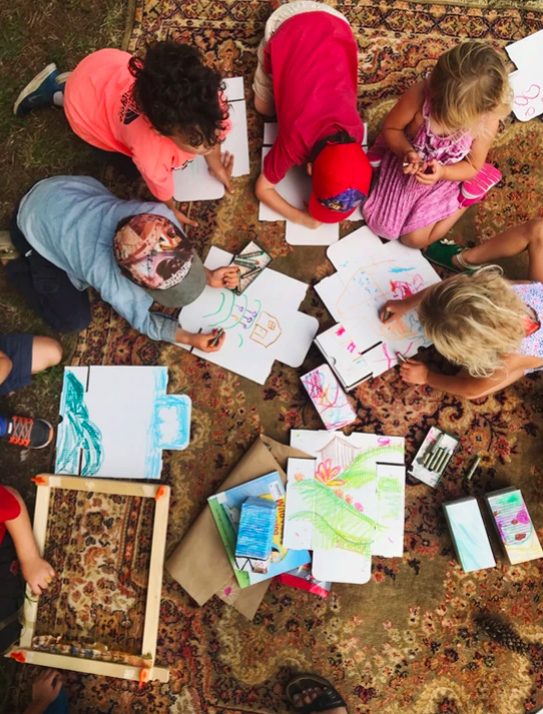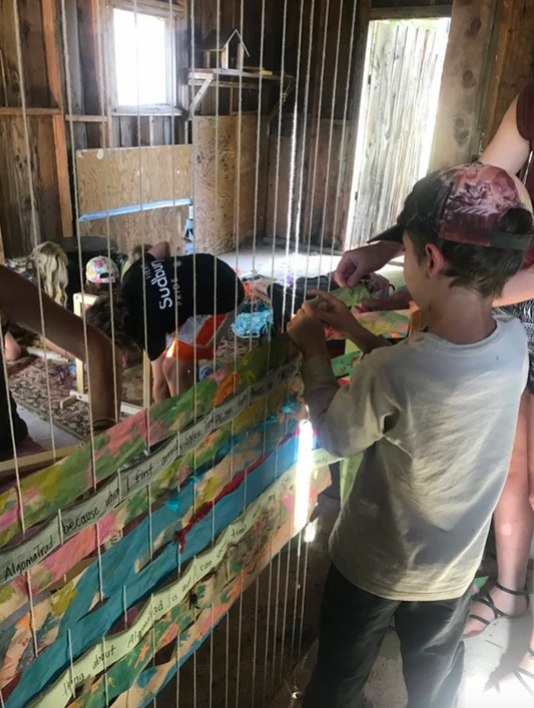First Reflections: Considering Community-Engaged Arts in Schools
Update on Practicum Experience
In November and December, I attended planning meetings with the What Was My Backyard?’s producing team, and other members of the artistic team. In these meetings, we developed a plan to bring the project into one pilot school. These meetings primarily concerned logistics: booking artists, writing contracts, managing the budget, scheduling workshops and communicating to partners. In particular, I took part in discussions about what the shape of this project might be within our three-day school residency.
Enacting the participatory vision for the show, I discovered, involved a complexity of scheduling artists and students (and working through related budget considerations), to make sure that students had the right amount of content introduction and rehearsal time. In this area, I was able to provide some insight from my experience of how school days flowed, and flag some considerations related to in-school activities, particularly regarding curriculum content at different grade levels.
Discussions arose around what ages to work with, the merits/limitations of separating disciplines (puppetry from singing from acting from making), procedure for creating groups, how to prep classroom teachers, and how to effectively use available school space. Although these were primarily logistical discussions, which informed the Director’s creation of an in-school plan, at the heart of them was a disciplinary tension and interplay between community-engaged arts and arts education: two fields with similar but not identical goals, that merge in this project.
What is Community Engaged Arts?
Informed by The Ontario Arts Council’s Framing Community – A Community-Engaged Art Workbook, created in 2017 by Maggie Hutcheson
Community-engaged arts project produced by The Community Arts Guild
There are many practices of art that engage with community; in Ontario, both the Toronto and Ontario Arts Councils recognize community engaged arts as a professional artistic “field” (Hutcheson, 2017, p. 5), in which “individuals who aren’t professional artists actively participate in the artistic process, and the artistic process is considered as important as the final artistic product.” (Hutcehson, 2017, p. 5) Community-engaged arts projects include non-artist participants but are led by professional artists (sometimes in partnership with organizations or community groups) (Hutcheson, 2017). They are often interdisciplinary (Hutcheson, 2017), and their outcomes are intentionally both artistic (performance, pageant, installation, object etc) and relational (Hutcheson, 2017). Although a range of contemporary artistic practices include a focus on collaboration, “community-engaged art is not just art that is made collaboratively, it is art that honours the perspectives, knowledge, stories, skills and cultural practices of community members.” (Hutcheson, 2017, p. 6)
"Community-engaged art is not just art that is made collaboratively, it is art that honours the perspectives, knowledge, stories, skills and cultural practices of community members.” (Hutcheson, 2017, p. 6)
Although approaches to and impulses behind community engaged art-making differ and vary, at their heart is a commitment to “radical inclusion” (Hutcheson, 2017, p. 7): “both making sure that a range of people can physically participate in the project and that their perspectives, knowledge and aesthetics are represented in the project.” (Hutcheson, 2017, p. 9). This commitment to inclusion is woven through the fabric of What Was My Backyard?. For example, Jumblies Theatre, one of the community-engaged arts producing partners, provided supports including childcare, transportation, food, ASL interpretation, PSW support and more to intergenerational participants in the What Was My Backyard? workshops for the community members outside of the school. Finding ways to bring these practices and values inside school walls was the focus of the early meetings I attended.
Community Arts in Schools: Connecting experience and literature
Hutcheson (2017) makes a distinction between educators and artists, although she notes that both may strive to “engage, educate, and challenge mainstream perspectives.” (Hutcheson, 2017, p. 7) Community-engaged art is purpose-driven (Hutcheson, 2017), however the artists working on this project did not, in my experience, describe the purpose of their work as “educational”, but closer to Hutcheson’s (2017) characterization as “artistic and social” (Hutcheson, 2017, p. 15).
Although new discoveries and relationships may be built out of a community-engaged arts process, the practice has an intrinsic value of “co-creation” (Hutcheson, 2017, p. 9), in which the “skills, knowledge, aesthetics and labour “ (Hutcheson, 2017, p. 9), of community participants (in this case, school children) plays a role in shaping an artistic outcome, in a way that inherently subverts and shifts the top-down power dynamics we are used to imagining in traditional arts spaces (Hutcheson, 2017) and classrooms.
In fact, Hutchehson (2017) positions community-engaged arts’ commitment to “radical inclusion” (Hutcheson, 2017, p. 7) as in opposition to “exclusionary practices and institutions” (Hutcheson, 2017, p. 7). Schools are institutions which we are likely to expect to have hierarchies, shut doors, age-specific groupings and clearly laid-out parameters (success criteria) — even in art classrooms, a reality which might feel incongruent to the values of a community-engaged art process. And this, in some ways, was the inherent tension that we were working through in our planning meetings.
For example, the first plan that we developed in December was for each class to be assigned a different art form (ex: one class of Grade 4’s would do puppetry, different Grade 4’s would do dance etc). However, one of the artists raised a concern about taking away the students’ agency to chose an art form, or even to experience fluid preferences, feeling that assigning groups would limit potential for their “perspectives” (Hutcheson, 2017, p. 10) to be included and valued.
"Inclusivity means both making sure that a range of people can physically participate in the project and that their perspectives, knowledge and aesthetics are represented in the project." (Hutcheson, 2017, p. 9)
When the Director asked me whether I thought it would be possible for students to be in cross-grade groups, I, admittedly, said I agreed that this was important, but couldn’t imagine the school letting it happen. Even as someone deeply excited by working in schools, and who is drawn to the possibility of bringing community-engaged arts approaches to school settings, my own imagination when considering what’s possible within a school’s institutional — often “oppressive” (Hutcheson, 2017, p. 53) — context was, it turned out, a little limited. This is something I hope to try to work through, recognize and challenge in myself, in order to make possible new realities within schools.
Because I do think there is a huge amount of promise to bring a community-engaged arts process into schools. Another core value of community-engaged art is “appreciation of difference” (Hutcheson, 2017, p. 10). In an arts project, bringing people together across difference is something that can require intentional work to reach communities and create welcoming, inclusive spaces. But in public schools, children are brought together across difference of experience, background and perspective every day, and work to share space and create community through “building relationships.” (Hutcheson, 2017, p. 50) Of course, there are lots of challenges to doing so, on both smaller and structural levels, but this internship has helped me think about how this work is, I think, actually deeply aligned to community-egaged arts, in its commitment to to relationship-building and “creat[ing] dialogue between different perspectives” (Hutcheson, 2017, p. 10). Recognizing this, made me even more deeply excited for being part of this project, and how it can help me deepen my own future practice.
Previous Arts-based lessons & workshops I have led:
Promising surprises:
final thoughts for now
In fact, when the Director spoke to the school, they agreed not only to allow students to choose their own groups, mixing across grades and home classrooms, but allowed the artistic team to take over the school auditorium and four classrooms for our groups to convene in. I discovered that even my short time of working in schools imposed institutional boundaries on my imagination that were not necessarily in service of the project’s goals. When I asked the Director why she thought this conversation with the school went so well, she reminded me that she had been working with the school staff and administration for a number of years, through smaller-scale partnership opportunities.
To centre “appreciation of difference” and genuine relationship building (Hutcheson, 2017) as part of a relational artistic process means “investing time” (Hutcheson, 2017, p. 9), and building connections and trust. In this case, I observed how having done so opened up new possibilities for this project, allowing the artists to work in a way that would allow them to best create inclusive, artistic environments for students. Although on this project, artists would only have three days to spend with students, the school residency was a part of a longer relationship between educators, artists and arts organizations.
This experience and realization helped me understand that, even in a school partnership, an understanding of community goes beyond simply students and teachers, to include a broader school and neighbourhood community, with whom genuine relationships and connections can have lasting social and artistic impacts that can, even in small ways, shift the boundaries of school norms, and create new possibilities for connection and change.
References
Hutcheson, M. (2017). Framing Community – A Community-Engaged Art Workbook. Retrieved from http://www.arts.on.ca/oac/media/oac/Publications/Framing-Community-ACommunityEngaged-Art-Workbook.pdf






